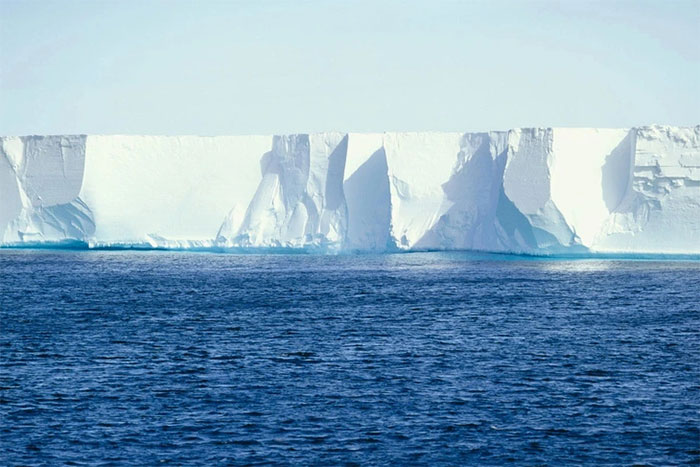The largest ice shelf in Antarctica is acting strangely
According to SciTechDaily, ice stream activity caused the Ross Ice Shelf in Antarctica to suddenly shift.
In Antarctica, giant glaciers are constantly shifting. Glacial streams, which act like conveyor belts, are pathways of accelerated movement that transport much of the ice and sedimentary debris from these vast glaciers toward the ocean.
According to new research from Washington University in St. Louis, one such ice stream pushed the entire Ross Ice Shelf out of position at least once a day. This discovery is very significant, because the scale of the Ross ice shelf is not small. This is the largest ice shelf in Antarctica , about the size of France.

The Ross Ice Shelf is a floating ice sheet, extending into the ocean from glaciers deep in Antarctica - (Photo: SciTechDaily).
"We found the entire ice shelf suddenly moved about 6cm to 8cm once or twice a day, due to caused by an ice stream flowing into the ice shelf. These sudden movements may play a role in triggering earthquakes and ice shelf rifts."
The Ross Ice Shelf is a floating sheet of ice, extending into the ocean from glaciers deep in Antarctica. Scientists are interested in the interactions between ice shelves and ice streams, partly because of concerns about the stability of Antarctic ice shelves in a world with warming temperatures.
The new study, published in the journal Geophysical Research Letters , focuses on movement caused by the Whillans Ice Stream, one of about half a dozen large, fast-moving glaciers that feed into the Ross Ice Shelf.
"Humans will not be able to detect the movement of the ice shelf just by feeling it. The movement occurs over a period of several minutes, so it cannot be detected without measuring equipment ," Wiens said.
"I have previously published several papers on sliding events in the Whillans Ice Stream, but until now I have not discovered that the entire Ross Ice Shelf also moves ," Wiens said.
Researchers don't think these slip events are directly related to human-caused global warming. One theory is that the phenomenon occurs due to dehydration of the Whillans glacial streambed, causing it to become "stickier" .
Sea levels will rise further when the ice shelf collapses
Ice shelves act as brakes for glaciers and ice streams, slowing their journey to the sea where they melt, thus allowing more ice to accumulate on the continent.
If an ice shelf collapses, the "brake" disappears and the glaciers are free to flow faster. Once flowing into the ocean, they contribute to rising sea levels.
Studies of glacial streams over the past 50 years show that some glacial streams are accelerating, others are slowing down. Scientists can use seismometers to detect sudden movements of ice streams, to help understand what drives this movement.
- The one trillion tons of ice has separated from Antarctica
- 4 scenario is happening when the largest iceberg in history has just broken in Antarctica
- Discovering a new ecosystem hidden under Antarctica's largest ice shelf
- The ice is as big as London in 'wobbly teeth' apart from Antarctica
- Discovering the role of ocean currents in ice shelf melting
- Video: Consequences of 1,000 billion tons of icebergs separated from Antarctica
- Marvel at the space below the Antarctic ice shelf at a depth of 300 meters
- New cracks appear after the trillions of ice caps have just split off from Antarctica
- Antarctica was once warm
- An ice shelf the size of Rome in Antarctica collapses
- The world's largest iceberg is at risk of breaking away from Antarctica
- The world's largest iceberg is about to enter the Atlantic
 Is the magnetic North Pole shift dangerous to humanity?
Is the magnetic North Pole shift dangerous to humanity? Washington legalizes the recycling of human bodies into fertilizer
Washington legalizes the recycling of human bodies into fertilizer Lightning stone - the mysterious guest
Lightning stone - the mysterious guest Stunned by the mysterious sunset, strange appearance
Stunned by the mysterious sunset, strange appearance